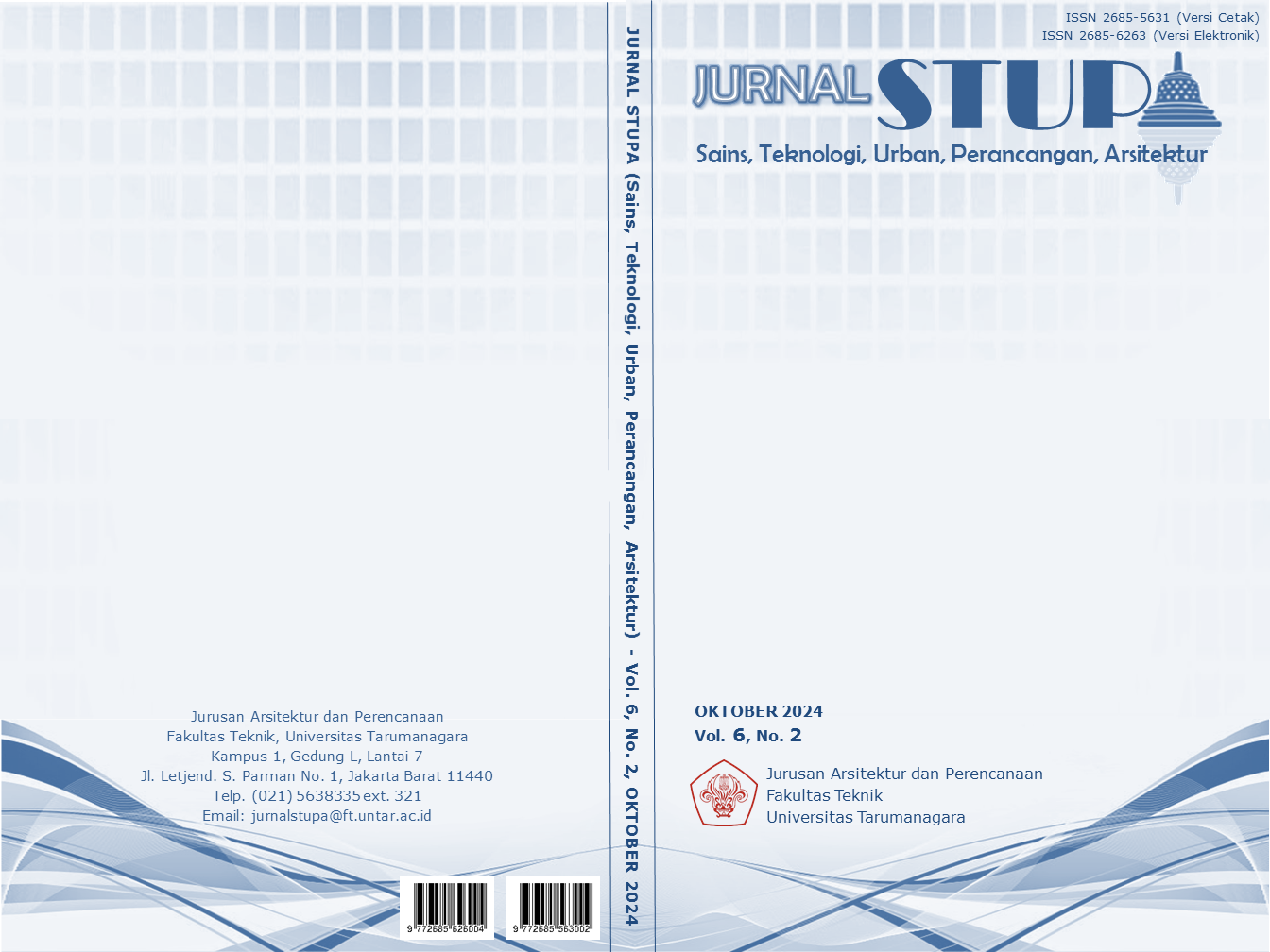PEMAKNAAN KEMBALI MEMORI KOLEKTIF DI SUNDA KELAPA MELALUI OBJEK WISATA SEJARAH DAN EDUKASI DENGAN METODE KONTRAS HARMONIS
Main Article Content
Abstract
Sunda Kelapa area is the forerunner of the economic driver in Jakarta that has been operating since the 5th century AD and has gone through several eras. More than just being the oldest port in Jakarta, the Sunda Kelapa area is designated as a historical tourist destination to open the knowledge of future generations about the nation's journey. Along with the times, the Sunda Kelapa area has experienced degradation of historical value and collective memory so that it is categorized as a placeless place. This is because the Sunda Kelapa area does not have a 'place' that attracts tourists to explore tourist objects around the area as an issue. The problem caused is the fading of local identity and collective memory, both historically and culturally so that the sense of place attachment to the area is decreasing. The goal is to recall the historical value and collective memory of Sunda Kelapa in an adaptive way without dismissing these values. With the method of harmonious contrast approach, the focus of architectural design emphasizes on creating tension and visual interest as a blend of past and present. The steps used include: 1) data collection, 2) survey, 3) analysis and conclusion. The result of the design is to create a historical and educational tourism environment that is adaptive, interactive, and digitized in an effort to revive historical values and collective memory in the midst of globalization so that the Sunda Kelapa area has a sense of place and identity.
Keywords: degradation; identity; memory; tourism
Abstrak
Kawasan Sunda Kelapa merupakan cikal bakal penggerak perekonomian di Jakarta yang telah beroperasi sejak abad ke-5 Masehi dan telah melalui beberapa zaman. Lebih dari sekadar sebagai pelabuhan tertua di Jakarta, kawasan Sunda Kelapa ditetapkan sebagai destinasi wisata sejarah untuk membuka pengetahuan generasi mendatang mengenai perjalanan bangsa. Seiring dengan perkembangan zaman, kawasan Sunda Kelapa mengalami degradasi nilai historis dan memori kolektif sehingga dikategorikan sebagai placeless place. Hal ini disebabkan kawasan Sunda Kelapa tidak memiliki ‘place’ yang menarik perhatian wisatawan untuk menjelajahi objek-objek wisata di sekitar kawasan sebagai sebuah isu. Masalah yang ditimbulkan adalah pudarnya identitas lokal dan memori kolektif, baik secara sejarah dan budaya sehingga rasa place attachment pada kawasan semakin menurun. Tujuannya untuk mengingatkan kembali nilai historis dan memori kolektif Sunda Kelapa dengan cara adaptif tanpa menepikan nilai-nilai tersebut. Dengan metode pendekatan kontras harmonis, fokus desain arsitektur menekankan pada terciptanya ketegangan dan visual interest sebagai perpaduan masa lalu dan masa kini. Langkah-langkah yang digunakan antara lain: 1) pengumpulan data, 2) survey, 3) analisis dan kesimpulan. Hasil perancangan untuk menciptakan lingkungan wisata sejarah dan edukasi yang adaptif, interaktif, dan terdigitalisasi dalam upaya meningatkan kembali nilai historis dan memori kolektif di tengah lajunya globalisasi sehingga kawasan Sunda Kelapa memiliki sense of place dan identitas.
Article Details

This work is licensed under a Creative Commons Attribution-NonCommercial-ShareAlike 4.0 International License.
This work is licensed under a Jurnal Sains, Teknologi, Urban, Perancangan, Arsitektur/ STUPA Creative Commons Attribution-NonCommercial-ShareAlike 4.0 International LicenseReferences
Akbar, P. N. G., & Edelenbos, J. (2020). Social impacts of place-making in urban informal settlements: A case study of Indonesian kampungs. Social Sciences, 9(6), 104.
Bodger, D. (1998). Leisure, learning, and travel. Journal of Physical Education, Recreation & Dance, 69(4), 28-31.
Budiman, R. (2022, November 21). Ingatan. Diambil kembali dari Tentang Sejarah: https://ingatan.id/pengertian-sejarah-menurut-para-ahli/
Dovey, K. (2016). Urban design thinking.
E. U. (2020, Juli 11). Revitalisasi Urban. Jakarta, DKI Jakart, Indonesia. Dipetik Februari 28, 2024, dari https://bahan-ajar.esaunggul.ac.id/tpl405/wp-content/uploads/sites/220/2019/11/25_Revitalisasi-Urban.pdf
Hidayat, H. D. (2022). Wisata Edukasi Biota Laut dengan Konsep Arsitektur Ekologis di Morowali= Marine Biota Educational Tour with Ecological Architectural Concepts in Morowali (Doctoral dissertation, Universitas Hasanuddin).
Meliansari, S. R., & Ellisa, E. THE PLACELESSNESS OF KAMPUNG KAPITAN PALEMBANG: CAGAR BUDAYA DI AMBANG KEHANCURAN. MODUL, 23(1), 50-59.
Notoatmodjo, S. (2003). Pendidikan dan perilaku kesehatan.
Prasetyo, A. D., Pitana, T. S., & Gunawan, G. THE CONCEPT OF HARMONY BY CONTRAST IN ARCHITECTURE ON THE DEVELOPMENT OF PURWOSARI STATION AREA. ARSITEKTURA, 16(1), 77-86.
Purwantiasning, A. W., Rosyadi, M. A., & Sari, Y. (2019). Pemahaman Metode Building Infill sebagai Penerapan Konsep KonservasiKawasan Bersejarah Melalui Studi Preseden. Prosiding Semnastek.
Relph, E. (1976). Place and placelessness. Pion Limited.
Seil, W. (2010). “Tito Time, o Time,” A Nation ” A Nation’s Idealiz s Idealized Past: Collectiv ast: Collective Memor e Memory and Cultural Nostalgia through the Memorialization of Charismatic Leaders. Pacific University, Colleges of Art and Sciences. Oregon: Social Sciences Capstone Projects. Dipetik June 3, 2024, dari https://dashboard.commons.pacificu.edu/downloads/2a601d3d-fb72-4022-ac0d-3cfcbb1436ee
Septiarani. (2021, Agustus 2021). Pelabuhan Sunda Kelapa. Dipetik Februari 14, 2024, dari Tribun News Wiki: https://www.tribunnewswiki.com/2021/08/11/pelabuhan-sunda-kelapa
SUJARMANTO, I. S. (2018). PENGARUH MEMORI KOLEKTIF TERHADAP MORFOLOGI KAMPUNG PITU DI YOGYAKARTA (Doctoral dissertation, UAJY).
Tuan, Y. F. (1977). Space and place: The perspective of experience. U of Minnesota Press.



